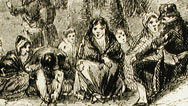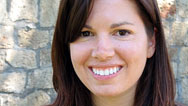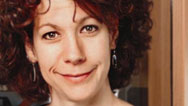Profile: Julie Schablitsky
- Posted 07.10.07
- NOVA scienceNOW
(This video is no longer available for streaming.) Historical archeologist Julie Schablitsky is rewriting legendary tales of the American frontier. She has found evidence that members of the Donner family did everything but resort to cannibalism during their ill-fated California trek with a group of settlers in the 1840s (some of whom did turn to forbidden flesh). Schablitsky is also shedding light on one of the most poorly documented aspects of life on the frontier: the history of Chinese laborers who built America's railroads and did other backbreaking work.
Schablitsky fills in the gaps of American history by analyzing the objects that pioneers left behind. She is one of the first archeologists to recover historic-period human DNA from an artifact—a medical syringe that had several users. While she's comfortable getting dirty in the archeological trenches, Schablitsky enjoys getting spruced up as what she calls "a lipstick archeologist."
Transcript
PROFILE: JULIE SCHABLITSKY
PBS Airdate: July 10, 2007
NEIL DEGRASSE TYSON: Most of us think of the Old West as the stuff of myth and legend and cowboy movies. But the West was made by very real people, and people always leave stuff behind. So if you're willing to get your hands a little dirty, like the archeologist in this episode's profile, you might just discover the real story behind the myth buried beneath the dirt and the sand.
JULIE SCHABLITSKY (University of Oregon): We're just about there. And this just might be a little deeper, or perhaps may go down even.
NEIL DEGRASSE TYSON: Julie Schablitsky is an historical archeologist with the University of Oregon.
JULIE SCHABLITSKY: I feel like I'm a shot-putter.
NEIL DEGRASSE TYSON: She's not afraid to get her hands dirty, as she digs for the truth, literally.
JULIE SCHABLITSKY: Oooh, looks like an alcohol bottle.
Each archeologist that goes off to a site is looking for a story.
It's a crown cap, though, so what's the middle mark? Is that C, G together? I can date that here.
A story that will tell them something different about the people who used to live there.
What does the base of the bottle say? An S?
Something that hasn't been known before.
"William Franz & Sons 1900-1929. Milwaukee, Wisconsin."
So the Holy Grail is not necessarily an object, it's a story.
NEIL DEGRASSE TYSON: Julie brings her passion for her science to what was once the site of a 19th century Chinatown, in John Day, Oregon. That's where she's trying to tell the story of the thousands of Chinese laborers who came West in the late 1800s.
JULIE SCHABLITSKY: The Chinese were instrumental in building the railroads. They were instrumental in mining. They made shoes; they were cobblers; they cut hair; they were servants in people's homes; they were cooks. Like all immigrant communities you really build a country on their backs.
NEIL DEGRASSE TYSON: Yet there are almost no written records from or about the Chinese of that era.
JULIE SCHABLITSKY: You don't see them documenting their life in journals. And very seldom do you find even letters that went back and forth between them and their families. So you have this gap of what it was like to be Chinese in 19th century America.
Ooh. Yup. It's a single-dose medicine bottle. It's Chinese, umhmm, Chinese, definitely Chinese.
And what archeology can do is it can fill in those gaps, and give the voiceless Chinese that voice.
NEIL DEGRASSE TYSON: Julie's love of archeology started very early. Her first digs took place on the gravel driveway of her Minnesota home where she grew up. By the time she was seven, this self-assured second-grader was telling her classmates she had found her life's calling.
JULIE SCHABLITSKY: Back then, I thought about archaeology as being a lot of the gold idols with the ruby eyes, and mummies, and things from a far away land. And I never realized that archeology could be in your own backyard.
NEIL DEGRASSE TYSON: An idea that grew along with her, through elementary school into high school. Even the poster on her bedroom door was of an atypical rock star.
JULIE SCHABLITSKY: Ramesses II is not the average teen idol, but I found him quite interesting.
NEIL DEGRASSE TYSON: Today her interests have gone beyond the idols and icons and even the physical artifacts themselves.
JULIE SCHABLITSKY: We found a coin purse.
MARY OBERST: Oh my gosh. Sure enough.
JULIE SCHABLITSKY: The bottle that you could pick up, the arrowhead you could hold in your hand, and think that, wow, someone made this—that's what really grabbed my interest. But what held it was that when I began to put these artifacts together and tell a story that was really important.
NEIL DEGRASSE TYSON: And that's exactly what Julie helped to do, on a headline-making excavation, involving one of the great and gruesome stories of the Old West: the story of the Donner party, the group of west-bound pioneers who, because of bad luck, an ill-chosen route, and early snows, were trapped in the California mountains for a bitter winter in 1846 to '47.
JULIE SCHABLITSKY: So you had a little over 80 people, stranded in the Sierra Nevadas, in two different camps. In both camps, about half the people lived and about half the people died.
NEIL DEGRASSE TYSON: Just what the living did to survive horrified everyone who heard the story. Some survivors in the larger of the two Donner party camps admitted they had cannibalized the bodies of those who had already died.
JULIE SCHABLITSKY: It seemed that everyone was assured that cannibalism was participated in by every single member of the Donner family party. I think a lot of people believe that they survived by eating each other.
NEIL DEGRASSE TYSON: Julie was the co-leader of a team that recently went back to the second camp, to get a fuller story of what really happed there, more than 150 years ago.
JULIE SCHABLITSKY: We wanted to know if they cannibalized. We wanted to know, if they didn't cannibalize, how'd they survive? How desperate did they become? What did they eat?
NEIL DEGRASSE TYSON: Julie's team discovered a buried hearth and a trove of burned and chop-marked bones. She took those bones, and did what she's become known for: Julie brought in experts from other scientific disciplines, in this case, forensic bone analysts.
Their findings? Those chopped, boiled bones were those of hunted deer and rabbit, of their horses, even dog, but no humans.
JULIE SCHABLITSKY: These people ate their family dog. They did everything in their power to extract every last nutrient before they did the unthinkable.
NEIL DEGRASSE TYSON: Thanks to Julie and her team, about half of the Donner party members at the second campsite were exonerated, correcting the sensationalized stories of the entire Donner party quickly resorting to cannibalism.
JULIE SCHABLITSKY: It looks like only several people did participate in cannibalism, and not until the very, very end of their entrapment. So I think that's a real big finding for us.
JON ERLANDSON (University of Oregon): I think she's something of an emerging star in historical archaeology.
JULIE SCHABLITSKY: Go!
NANCY NIEDERNHOFER (Oregon Parks and Recreation Department): One of the things that I love so much about Julie, and I especially enjoy working with her, is the enthusiasm.
JULIE SCHABLITSKY: That's way cool.
NANCY NIEDERNHOFER: It's so infectious.
JULIE SCHABLITSKY: Oh, wait. Oh, my gosh. I think this is a soy s.... It looks like right on top of this board here is a spout from a soy sauce bottle, a Chinese soy sauce bottle. There's no doubt what this is.
MARIE POKRANT (Site Volunteer): She is really there to really help in times when your work is...long, hot days, and it's frustrating work. She's still, like, being the cheerleader.
NEIL DEGRASSE TYSON: Which in fact she used to be. She's always been active—the volunteer firefighting, snowboarding kind of active. And she says she's always been a tomboy—but the kind that's never been afraid to wear pink, or to poke fun at herself, or try something new.
JULIE SCHABLITSKY: Oh, Susanna.
There's both the part of me that can be dressed up and feminine, but at the same time can also be a scientist who likes to play in the dirt. And I've always been true to who I am, and I've always been comfortable with being, I guess, a lipstick archeologist, if you will.
NEIL DEGRASSE TYSON: But make no mistake, this lipstick archeologist is not someone to be taken lightly. Julie's one of the first archeologists in her field to discover historic period DNA from an artifact.
She excavated this glass syringe from a site in Virginia City, Nevada.
JULIE SCHABLITSKY: Nowadays forensics and DNA is a household word, and I wanted to understand what the syringe was used for. I wanted to know who used it. Knowing that it came from a 19th century structure just was not enough for me.
DNA tests revealed that at least four people had used the syringe to inject an opiate, most likely morphine. They were both men and women used that syringe, and perhaps one of those individuals was from African descent. And I would never have been able to know that just using traditional archaeological methods.
And one thing we're not finding is, there are no women's personal items, and that's because we're in a bachelor culture, really.
JON ERLANDSON: She's really good at interpreting history for the public. We have to share our findings with them and make it interesting, not just blasé.
JULIE SCHABLITSKY: This came all the way from China, back in the late 19th, early 20th century. And it's either from a food storage jar or....
My goal as an archaeologist is not just to dig up the artifacts, put them in a bag and put them in a museum somewhere, but to get that out to the public, people that have an interest in who was here before them.
NEIL DEGRASSE TYSON: Julie Schablitsky's commitment to her science is driven by her passion to understand the past, to re-construct history, one artifact at a time.
JULIE SCHABLITSKY: Even little bits and pieces from a Chinese trash pit...
This is excellent preservation.
...or DNA from a syringe can be brought together to tell a bigger story.
Oh, well, good. That's a nice, complete piece.
NEIL DEGRASSE TYSON: Julie even married an archeologist: Bob Nyland, an underwater archeologist with the US Navy.
JULIE SCHABLITSKY: He's water, I'm land. So he shares my passion. If you really have a drive for something, a desire, this passion that is inside of you, don't ever think, "Oh, I can't do it." I think it's very, very rare that people take a passion that they have, and turn it into a profession. But I think it's completely possible.
Credits
Julie Schablitsky Profile
- Edited by
- Stephen Mack
- Produced by
- Carla Denly & Beth Nissen
NOVA scienceNOW
- Executive Producer
- Samuel Fine
- Executive Editor
- Neil deGrasse Tyson
- Senior Series Producer
- Vincent Liota
- Supervising Producer
- Stephen Sweigart
- Editorial Producer
- Julia Cort
- Development Producer
- Vinita Mehta
- Senior Editor
- David Chmura
- Post Production Supervisor
- Win Rosenfeld
- Unit Manager
- Candace White
- Associate Producers
- Sarah Kinsella
- Anthony Manupelli
- Shimona Shahi
- Production Assistant
- Alison Snyder
- Production Secretary
- Fran Laks
- Animator
- Brian Edgerton
- Compositor
- Yunsik Noh
- Camera
- James Ball
- Mike Coles
- Mark Daniels
- Brian Dowley
- Bill McMillan
- Clive North
- Sound Recordists
- John Cameron
- Nicolas Dalban
- Paul Flinton
- Bill Heinlein
- George Hitchins
- Kevin Meredith
- Keith Rodgerson
- Ted Roth
- Josh Tallo
- Audio Mix
- Jim Sullivan
- Colorist
- Jim Ferguson
- Animation
- Vincent Liota
- Steve Popplewell
- Additional editing for CERN segment
- Paul Dawe
- Kevin Hanna
- Music
- Rob Morsberger
- Production Manager for CERN Segment
- Selina Kay
- NOVA scienceNOW series animation
- Edgeworx
- Three dimensional brain animation
- Courtesy Dr. Arthur W. Toga, Laboratory of Neuro Imaging at UCLA.
- Archival Material
- Bettmann/CORBIS
- Eric Bailey, Copyright, 2005, Los Angeles Times. Reprinted with permission.
- The Leonard Bernstein Office, Inc.
- Devaki Bhaya, Carnegie Institution
- California Historical Society, FN-25345
- California State Parks, Sutter's Fort Archives
- CERN
- CORBIS
- Denver Public Library, Western History Collection, Z-8843
- IBM Corporate Archives
- Library of Congress
- Steve Mitchell, emedia
- New York Philharmonic
- Courtesy Oregon Parks and Recreation Department, 2006
- Oxford Scientific (OSF)
- Torleif Svensson/CORBIS
- Truckee Donner Historical Society
- Vancouver Public Library, Special Collections
- Special Thanks
- CERN
- David Deamer
- Marco Antonio Delgado Mayordomo
- Alison North – The Rockefeller University Bio-Imaging Resource Center
- Neil deGrasse Tyson
- is director of the Hayden Planetarium in the Rose Center for Earth and Space at the American Museum of Natural History.
- NOVA Series Graphics
- yU + co.
- NOVA Theme Music
- Walter Werzowa
- John Luker
- Musikvergnuegen, Inc.
- Additional NOVA Theme Music
- Ray Loring
- Post Production Online Facility
- The OutPost
- Closed Captioning
- The Caption Center
- NOVA Administrator
- Ashley King
- Publicity
- Eileen Campion
- Anna Lowi
- Yumi Huh
- Lindsay de la Rigaudiere
- Researcher
- Gaia Remerowski
- Production Coordinator
- Linda Callahan
- Unit Manager
- Carla Raimer
- Paralegal
- Raphael Nemes
- Talent Relations
- Scott Kardel, Esq.
- Janice Flood
- Legal Counsel
- Susan Rosen Shishko
- Assistant Editor
- Alex Kreuter
- Associate Producer, Post Production
- Patrick Carey
- Post Production Supervisor
- Regina O'Toole
- Post Production Editor
- Rebecca Nieto
- Post Production Manager
- Nathan Gunner
- Business Manager
- Joseph P. Tracy
- Producers, Special Projects
- Susanne Simpson
- Lisa Mirowitz
- Coordinating Producer
- Laurie Cahalane
- Senior Science Editor
- Evan Hadingham
- Senior Series Producer
- Melanie Wallace
- Managing Director
- Alan Ritsko
- Senior Executive Producer
- Paula S. Apsell
This material is based upon work supported by the National Science Foundation under Grant No. 0229297. Any opinions, findings, and conclusions or recommendations expressed in this material are those of the author(s) and do not necessarily reflect the views of the National Science Foundation.
NOVA scienceNOW is a trademark of the WGBH Educational Foundation
NOVA scienceNOW is produced for WGBH/Boston by NOVA
© 2007 WGBH Educational Foundation
All rights reserved
- Image credit: (Julie Schablitsky) Courtesy Carla Denly
Participants
- Jon Erlandson
- University of Oregon darkwing.uoregon.edu/%7Eanthro/faculty/erlandson.html
- Nancy Niedernhofer
- Oregon Parks and Recreation Department
- Marie Pokrant
- Site volunteer
- Julie Schablitsky
- University of Oregon home.teleport.com/%7Ejulschab/julie.html
Related Links
-

Traces of the Donner Party
Archeologist Julie Schablitsky describes what she and colleagues discovered at the Donner family campsite.
-

Julie Schablitsky: Expert Q&A
Historical archeologist Julie Schablitsky answers questions about her life and work.
-

Profile: Bonnie Bassler
Her insight into how bacteria "talk" has launched a revolution in biological and medical research.
-

Profile: Caroline Moore
Teen astronomer Caroline Moore, who has discovered a supernova and visited the White House, sings an Irish ballad.



